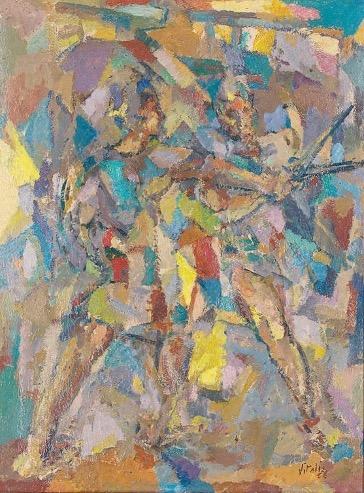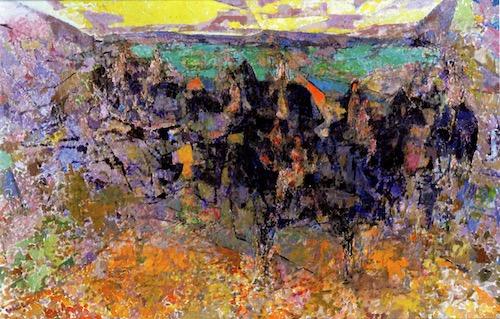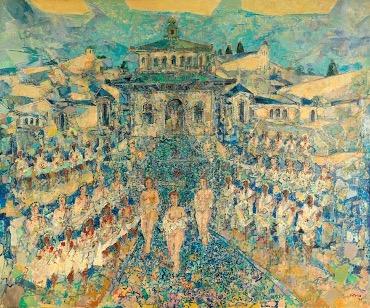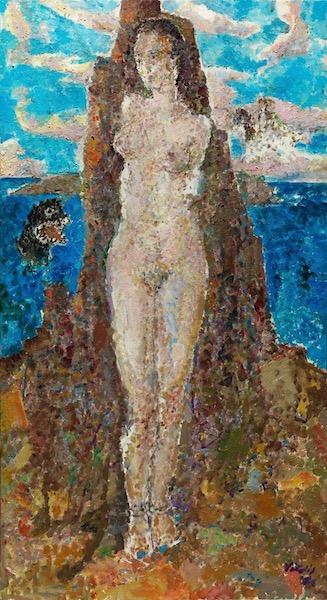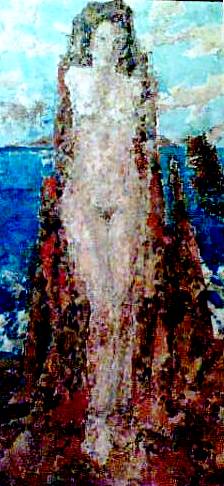

VITALIS, jury du concours de costume médiévial des élèves de 5ème du collège de Plestin-les-Grèves, en 1977
Mythology and antiquity have inspired VITALIS
These were not frequently visited themes, but VITALIS’ forays into the lands of antiquity or mythology are not lacking in originality or colour.
A gladiatorial combat, whose energy and violence are expressed by the small facets of shapes and colours that surround the scene. The swords intertwine, it is a painting with rhythm! This painting was sold at Christie’s London in 2010 with a peculiarity: on its website, then in all art databases, the painting is presented … upside down !
Gladiatiors – hst – 1956
Next came Amazons, a theme visited twice by VITALIS. The second Amazons, from 1960, constitutes the best auction sale of a VITALIS painting to date (see the bulletin “VITALIS in the art market”). It decorated the restaurant in the back of the room of Camille RENAULT’s “Bateau de pierre” (see the bulletin “VITALIS and Camille RENAULT”).
Amazones 1 – hst – 1956
Amazones 2 – hst – 1960
Earlier (1954) a Saint George had appeared, striking down a dragon with his spear. Here again we see a dynamic scene in a colourful cubist style.
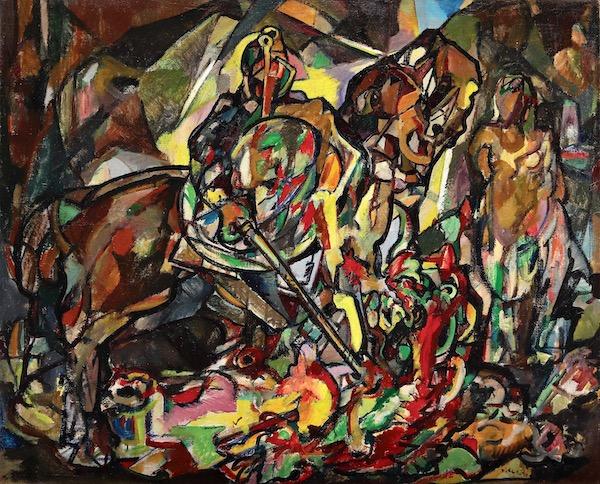
St George and the dragon – pastel – 1954
Then VITALIS takes us on a “Promenade au bord de la rivière”, with an astonishing destiny: offered by VITALIS to the old people’s home of Plestin-les-Grèves (with two other paintings), this monumental painting (more than one meter high and three meters long) had disappeared… before being recently found, in three parts (see bulletin n°4 “In pursuit of the lost VITALIS”).

Promenade au bord de la rivière – hst – 1974
And VITALIS invites us into an astonishing “Temple of Love”. Three naked women, musicians, a temple surrounded by buildings: a plunge into the “Thousand and One Nights” according to the former owner of the painting (see card). But one can also imagine being in the middle of the “House of Pleasures”, a utopia by Charles-Nicolas LEDOUX…
Le temple de l’Amour – hst – 1978
Finally, VITALIS has revisited the myth of Andromeda on several occasions. Four known paintings to date, in exactly the same composition at first glance. But note well: the whale-monster Ceto sometimes appears to the left, sometimes to the right of the chained beauty. Similarly, Perseus the horse emerges from the sky on horseback, clearly to the right of the first Andromeda (1978-7), much more fleetingly to the left in the other paintings (silhouette of the horse).
(voir ci-après une partie du mythe d’Andromède d’après Wikipédia)
“Cassiopée, ayant proclamé que sa fille (ou, selon d’autres versions, elle-même) était d’une beauté égale à celle des Néréides, les nymphes marines qui servent d’escorte à Poséidon, s’est attiré la colère de ce dernier. Pour se venger, le dieu de la mer provoque une inondation et envoie un
monstre marin (la baleine Céto) qui se met à détruire hommes et bétail. Désespéré, le roi Céphée consulte l’oracle d’Ammon qui révèle qu’aucun répit n’aura lieu tant que le roi n’aura pas livré sa fille au monstre.
Andromède est donc enchaînée nue à un rocher près du rivage. Persée, de retour après sa victoire sur la Gorgone Méduse, l’aperçoit du ciel
et s’informe de ce qui lui est arrivé. Il en tombe immédiatement amoureux et promet à Céphée de tuer le monstre à condition de pouvoir épouser Andromède. Il attaque alors le monstre avec son glaive et le massacre après
une lutte acharnée au corps à corps, sans recourir au pouvoir pétrifiant de la tête de Méduse. Selon Ovide, après sa victoire, Persée dépose cette tête sur un lit d’algues, qui rougissent et durcissent à son contact,
devenant ainsi la source du corail.” Wikipiédia.fr
